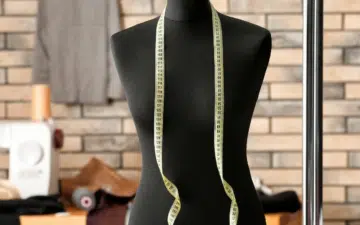If you’re a home sewist, you’re probably used to working with commercial patterns. But if you find yourself constantly adjusting them to fit your size, then drafting your patterns could be an empowering solution. After all, patternmaking can open the door to new ideas, designs, and, of course, a great fit!
The best part is that anyone can learn pattern drafting. These 6 Easy Tips for Drafting Sewing Patterns will have you on your way to creating your gorgeous collection.
1. Build a Sloper Library
A sloper is a templated pattern you create based on your measurements. It’s an essential building block of pattern drafting, and it’s the key to getting quick and efficient results. This is why it makes sense to have more than one. Developing your sloper collection means you don’t have to reinvent the wheel every time you draft a new pattern. Start with a bodice, pants, and sleeves sloper — from those, you’ll be able to add length and width to various spots to achieve the right fit.
3. Get the Right Tools
Here’s the good news: it’s very likely you already have the necessary tools to start pattern drafting. All you need is some paper, pens and pencils, scissors, tape, a tape measure, a French curve, and a tracing wheel. This post: Pattern Making Tools, Supplies, and Equipment will guide you to ensure you have the right tools.
4. Feel Free to Skip the Software
You don’t have to invest in pattern drafting software from the get-go. Yes, it can be fun to use, but it also tends to be expensive and may not be worth the cost for the casual pattern maker. Instead, you can achieve similar results by drafting by hand with a few essential tools and a bit of patience. Then, when you’re ready to invest more monetarily, you can level up. For example, I use Adobe Illustrator and have found it works great for the patterns I make.
5. Learn Pattern Grading
Knowing how to grade a pattern up or down in size is incredibly helpful, and there are two straightforward methods cut-and-spread and shifting. Having these techniques in your back pocket will also be beneficial whenever you want to recreate a favorite garment in a larger or smaller size from its original. We cover and use both methods on this site.
6. Take Ease Into Account
Ease is the difference between the actual body measurements you take and the measurements of the finished garment. Ease can have a significant impact on how the garment fits. For example, a form-fitting knit garment should have negative ease, while a form-fitting woven one will have less ease than a loosely-fitting version. The amount of ease is dependent on the type of fabric (how much stretch it has, if any) and how you want the garment to function, so it’s essential to consider when pattern drafting.
7. Join a Patternmaking Community
Finding the right community of makers can help you stay supported, inspired, and motivated. We'd love to have you join our private Facebook group.
Those are 6 Easy Tips for Drafting Sewing Patterns. Do you have any tips of your own? Please share them in the comments or our Facebook group.




Leave a Reply